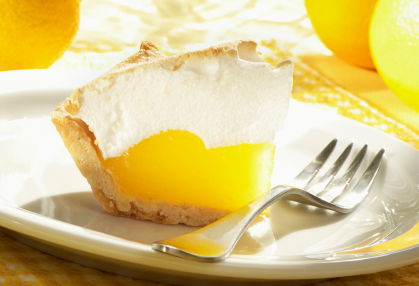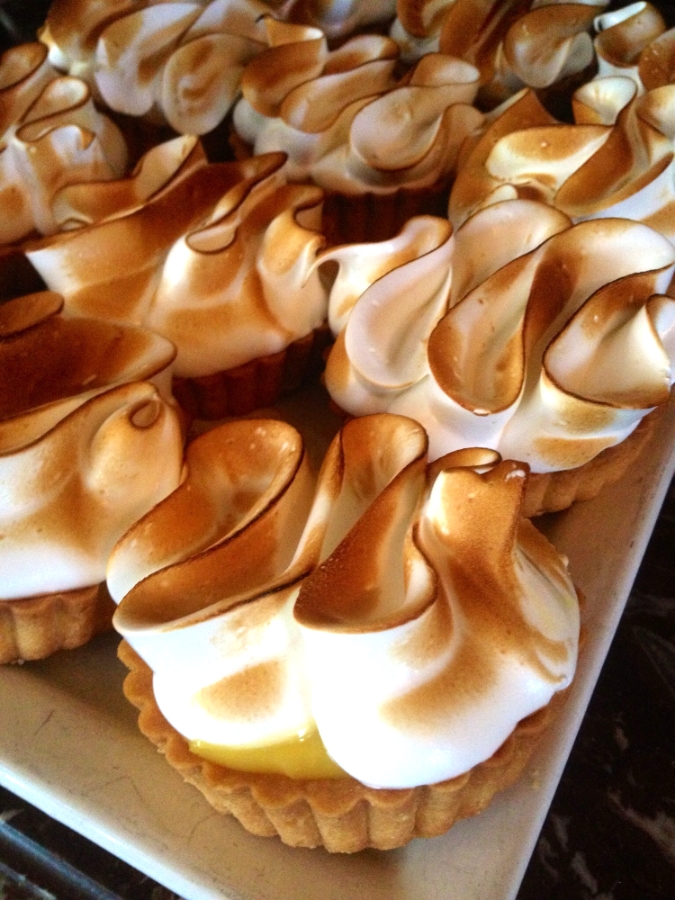My mom was an amazing pie maker- I've said it a million times. She made a pie or cobbler almost every single day and when I'd come home to Birmingham from my travels, I always knew I could always count on there being a Lemon Meringue Pie waiting for me. It is one of my favorite memories and certainly one of my favorite pies. Make one of these for someone special in your life and start a tradition of your own.
I wish I could take credit for those gorgeous swirled tarts on the right- those are from Chez Fonfon in Birmingham. I just wanted to show you that meringue can be a light to deep golden brown, depending on your taste. They make the swirls using a large pastry bag fitted with a wide, flat tip.
OLD-FASHIONED SOUTHERN LEMON MERINGUE PIE
For a 9 inch pie or 8 tarts, depending on the size of your tart pans
INGREDIENTS
1- pie crust for a 9" pie plate, pre-baked (homemade or store bought)
LEMON MERINGUE FILLING
1 cup sugar
3 tablespoons cornstarch
1/4 teaspoon salt
1 3/4 cups whole milk
4 large egg yolks, beaten well. (Save the egg whites for the meringue)
1 1/2 teaspoons finely grated lemon zest
1/3 cup freshly squeezed lemon juice
3 tablespoons butter, room temperature
MERINGUE
5 egg whites
1/4 cup plus 2 tablespoons sugar
1/2 teaspoon cream of tartar (find it in the spice aisle)
1/2 teaspoon vanilla
DIRECTIONS:
Preheat the oven to 350 degrees F.
FOR THE FILLING: Separate the egg yolks and whites. Put the yolks in a heat-proof bowl and beat them until they are slightly thickened. Add the sugar, salt, and cornstarch to a medium saucepan. Use a fork to combine the ingredients. Add the milk, 1/4 cup at a time, whisking each addition to incorporate very well. Cook over medium heat, stirring constantly, until the mixture comes to a boil. Boil exactly one minute, stirring constantly to keep it from burning. Remove from the heat. Carefully temper the egg yolks with the hot mixture by whisking 1/4 cup of the hot liquid into the eggs, stirring to incorporate. Whisk another 1/4 cup of the hot mixture to the eggs and then turn the tempered egg mixture into the saucepan.
Cook over medium heat for 3 minutes, stirring constantly. Remove from the heat. Add the lemon zest, lemon juice, and butter. Stir well to combine. Set aside.
FOR THE MERINGUE: Put the egg whites in a very clean mixing bowl. Beat on high speed for 30 seconds until the whites are frothy. Add the cream of tartar, beating on medium high until soft peaks form. Next, add the sugar, one tablespoon at a time until all the sugar is added and stiff, shiny peaks form. This takes about 3-4 minutes. Beat in the vanilla.
ASSEMBLY: Some people butter the bottom of a baked pie shell to act as a barrier between the filling and the crust so it won't get soggy. I did not do this step but you can if you like. Pour the filling into the pre-baked crust. Spread the meringue over the pie filling. The key is to make sure to spread the meringue all the way to the edges so the meringue doesn't shrink away from the crust as it bakes.
Bake the pie at 350 degrees F. for 15 minutes or until the meringue is golden. Cool the pie on a wire baking rack until it is cool (about 1 hour) and then put it into the refrigerator to cool completely before cutting it. (I usually allow it to chill in the fridge for at least 3 hours before serving. You can chill it less time but the filling might be not be completely set.)






